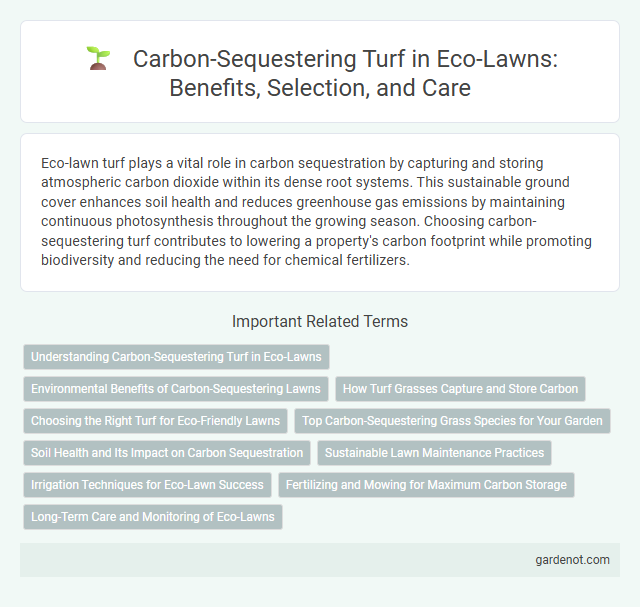Eco-lawn turf plays a vital role in carbon sequestration by capturing and storing atmospheric carbon dioxide within its dense root systems. This sustainable ground cover enhances soil health and reduces greenhouse gas emissions by maintaining continuous photosynthesis throughout the growing season. Choosing carbon-sequestering turf contributes to lowering a property's carbon footprint while promoting biodiversity and reducing the need for chemical fertilizers.
Understanding Carbon-Sequestering Turf in Eco-Lawns
Carbon-sequestering turf in eco-lawns captures atmospheric carbon dioxide, storing it in soil and plant biomass to reduce greenhouse gases. This turf type uses deep-rooted grasses and native plant species to enhance soil organic carbon content effectively. Incorporating carbon-sequestering turf supports sustainable landscaping by improving soil health and promoting long-term carbon storage.
Environmental Benefits of Carbon-Sequestering Lawns
Carbon-sequestering turf captures atmospheric carbon dioxide, storing it in soil and plant biomass, which significantly reduces greenhouse gas levels. These eco-lawns enhance soil health, increase biodiversity, and improve water retention, contributing to a resilient urban ecosystem. By minimizing the need for chemical fertilizers and frequent mowing, carbon-sequestering lawns lower carbon emissions and decrease environmental pollution.
How Turf Grasses Capture and Store Carbon
Turf grasses capture carbon dioxide through photosynthesis, converting CO2 into organic carbon stored in their roots and soil. Deep root systems in eco-lawns enhance carbon sequestration by increasing soil organic matter and microbial activity. This process not only reduces atmospheric carbon but also improves soil health and resilience against erosion.
Choosing the Right Turf for Eco-Friendly Lawns
Selecting carbon-sequestering turf varieties like fine fescues or buffalo grass enhances eco-friendly lawns by maximizing soil carbon storage. These grasses require less water and fertilizer, reducing greenhouse gas emissions associated with lawn maintenance. Incorporating native species adapted to local climates further supports carbon sequestration and promotes biodiversity.
Top Carbon-Sequestering Grass Species for Your Garden
Top carbon-sequestering grass species for eco-lawn projects include Kentucky bluegrass, Bermuda grass, and tall fescue, known for their high root biomass and soil carbon storage capabilities. These grasses not only enhance garden aesthetics but also significantly reduce atmospheric CO2 by converting it into organic carbon within the soil. Selecting species with deep root systems optimizes carbon sequestration potential while maintaining drought resistance and soil health.
Soil Health and Its Impact on Carbon Sequestration
Carbon-sequestering turf enhances soil health by increasing organic matter and microbial activity, which boosts the soil's capacity to store carbon dioxide. Healthy soil with diverse microbial communities improves nutrient cycling and promotes deeper root growth, leading to greater carbon retention. This process not only mitigates atmospheric CO2 but also supports sustainable ecosystem resilience and productivity.
Sustainable Lawn Maintenance Practices
Carbon-sequestering turf plays a crucial role in sustainable lawn maintenance practices by capturing atmospheric carbon dioxide and storing it in soil organic matter. Implementing eco-lawn techniques, such as reduced mowing height, organic fertilization, and minimal irrigation, enhances carbon uptake while promoting biodiversity and reducing chemical runoff. These practices contribute to lowering the lawn's carbon footprint and improving long-term soil health and resilience.
Irrigation Techniques for Eco-Lawn Success
Efficient irrigation techniques are vital for maximizing the carbon-sequestering capabilities of eco-lawns by promoting deep root growth and soil respiration. Drip irrigation and smart sensors reduce water waste while maintaining optimal moisture levels, enhancing turf health and carbon uptake. Implementing rainwater harvesting systems further conserves resources, supporting sustainable turf management and long-term ecological benefits.
Fertilizing and Mowing for Maximum Carbon Storage
Fertilizing eco-lawn with slow-release, organic nutrients enhances soil microbial activity, promoting deeper root growth and increased carbon sequestration. Mowing at higher heights maintains leaf area for optimal photosynthesis, which maximizes carbon capture and soil organic matter accumulation. Regular, moderate mowing frequency prevents plant stress, supporting sustained biomass production and long-term carbon storage in turf ecosystems.
Long-Term Care and Monitoring of Eco-Lawns
Eco-lawns with carbon-sequestering turf require ongoing long-term care and monitoring to maximize their environmental benefits. Regular assessments of soil carbon levels, turf health, and biodiversity indicators ensure sustained carbon capture and ecosystem stability. Implementing adaptive turf management practices such as minimal mowing, organic fertilization, and controlled irrigation supports the longevity and carbon sequestration capacity of eco-lawns.
Carbon-sequestering turf Infographic

 gardenot.com
gardenot.com